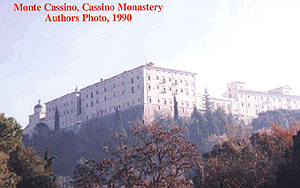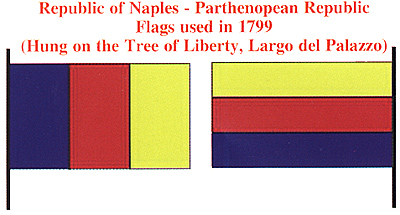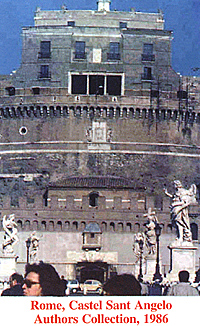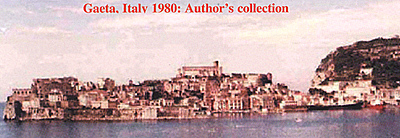A Tapestry of Kings,
Fools, and Traitors
The Formation and Fall
of the Parthenon Republic
of Naples in 1799
Naples Declares War on Rome
by Robert Fletcher, USA
| |
War was declared by Bourbon Naples against the Roman Republic, with the French forces being "invited to leave Rome", so the Neapolitans could return the "true government" to rule. The invasion of the Roman Republic commenced the 23d of November as the first Neapolitan troops crossed the border. The invading Army of Naples totaling some 40,000 men was divided into 3 columns and an independent marine expeditionary force. General Mack retained overall command of the Bourbon army, but also commanded the 22,000 strong main column heading for Rome along the road from Cassino.
General Micheroux commanded the eastern column advancing from the Abruzzi region. General Damas, a French expatriate, commanded the third column, advancing west on Rome byway of Lazio. General Diego Naselli. commanded the marine expedition, embarking at Gaeta setting sail for Livorno (Leghorn). The Bourbon forces made no provision for supply lines or keeping communication between the columns, placing each of the Neapolitan commanders on his own. On November 27th, General Mack's main column entered Rome after skirmishing with the French rearguard. The French left Rome's citadel fortress, the Castle of Sant Angelo, garrisoned and prepared for siege with 500 men and cannon. The Neapolitans upon entering the city were described as looking more like a defeated army than a victorious one as rain fell upon them.
Two days later, General Mack, King Ferdinand IV, and his staff entered Rome. Orders were given to cut down the Trees of Liberty, and hunt down supporters of the French. Many Jews were beaten or killed as purported French supporters, being thrown in the Tiber River during the Neapolitan forces occupation. Mack ordered a blockade of the castle to start, as he determined his next plans. On 28 November, General Naselli disembarked at Livorno invading the small Dukedom, unopposed by the Grand Duke and his feeble forces, which wished to remain neutral during the conflict. Naselli, without further initiative remained in Livorno's environs. The first Neapolitan Bourbon defeat of the campaign occurred when Micheroux's column encountered the French in a defensive position. The Neapolitans attacked, and were counterattacked by the French. The Neapolitans were quickly defeated and fled the field in rout. Micheroux was unable to rally his column, which never again constituted further opposition to the French. On 29 November, Ferdinand IV entered Rome in triumph as an alliance between Naples and Russia was signed and on December 1, a new accord was signed with Britain to prevent any sea borne attacks or landings by the French Navy. General Mack sent a message to the French occupied fortress of Sant Angelo calling for it to surrender.
In his communication he also intimated if the fort fired on the city, orders had been given to shoot a Frenchman or hand over a French soldier to the mob for each incident. A number of French sick and wounded had been left in a Rome hospital and were decidedly imperiled by the Neapolitans. Mack sent out victorious communiques to the court in Naples and after his brief pause in Rome, finally decided upon a course to pursue the French and bring them to battle. French General Championnet and his Army of Rome had not been idle during Mack's sojourn in Rome. He had ordered a concentration of available forces North of Rome and placing his headquarters at Term. The French rearguard conducted a fighting retreat, skirmishing with the Neapolitans daily as they advanced. Mack's Neapolitan advance guard first marched to Civeta Castellana, a good defensive position occupied by the French, who retreated no farther. On December 4, Mack gathered the Neapolitan army before the French positions and ordered three separate attacks, on the left, the right, and frontally. French General McDonald repulsed all three attacks and ordered the French forward in a counterattack, which broke the Neapolitan column. The demoralized Neapolitans and Mack fled attempting to regroup. Upon hearing of a French advance Mack ordered the Neapolitans to retreat back to Rome on the 5th of December. ne Neapolitan attempted invasion of Rome was already over. On December 12, King Ferdinand fled Rome by fast coach, dressed in one of his chamberlain's clothing, in fear of assassination or robbery. The King arrived in Caserta on the evening of December 13th, pausing briefly before continuing his flight to Naples. No preparations for defense of the kingdom had been made, and in Mack's favor, the routed Neapolitan army didn't stop to listen to him anyway. Each column and the Livorno expedition had been abandoned to their own fates. As Mack departed Rome, Damas and his column had nearly arrived. Finding out that Rome was abandoned and the army in retreat, General Damas, initiated an orderly retreat, even though the French pursued him. The French under Championnet quickly liberated Rome without a fight, reinstalling the Roman Republic.
Unlike Mack's dalliance in Rome, Championnet ordered the French Army forward into the Kingdom of Naples, hoping not to give the Neapolitans time to reorganize. But, as the Army of Naples retreated through the towns, the Neapolitan civil, state and military forces present disintegrated. Throngs of deserters and peasantry fleeing the French joined Neapolitan bandits or "Banditti", always a threat in the Kingdom of Naples during the best of times. The Neapolitan clergy and Noblemen held community meetings and presented the French as devil worshipers coming to desecrate the church and destroy all sacred values. Printed handbill propaganda depicts the French as rapists and thieves and the Neapolitans and Allies as blessed by God. The kingdom began to fall into lawless chaos, with armed bands roaming the countryside with Monarchists, Republicans, and the common people all equal targets. The capital of the kingdom, Naples, was filled with uncontrollable crowds called "Lazzaroni" or "Lazzari", roaming the streets participating in protests, looting, fights, and demonstrations. One of the king's courtier messengers was beaten to death in front of the Royal Palace, having been accused of being a "Republican". The French advance into the kingdom of Naples was fast and only slowed one column advancing into the Abruzzi region as they fought the Banditti. In the face of such anarchy, King Ferdinand, Queen Marie Caroline, Minister Acton, and the English Ambassador Hamilton planned an escape to Sicily. Valuables, furniture, the Treasury, and members of the Court were embarked in Nelson's British fleet, at anchor in the Bay of Naples. Ferdinand, not fully trusting his own Neapolitan Navy, prefer-red to embark on the Vanguard with Nelson on December 21, thus adding injury to insult to the proud Neapolitan fleet and it's commanders. The Neapolitan fleet, under command of Admiral Francesco Caracciolo, was made to take up station behind the British. Unable to depart the Bay due to stormy weather, both fleet waited in high seas, their passengers seasick, finally departing on the 23rd. As the weather battered British and Neapolitan ships carrying the King entered Palermo on December 25th, the city of Naples was left in utter confusion, the appointed regent, Prince Francesco Pignatelli unsure of his position. The "Defender" of Naples, General Mack, was still ostensibly in control of the Army as he attempted to raise a new conscript levy. The Naples Municipal Council called the "Vicario" ordered the formation of a Civic Guard and implementation of anti-Jacobin policies calling for the "death of all known Jacobins" and the destruction of their property. Prince Pignatelli was under orders to destroy all supplies and magazines to deprive the French of their capture, and started with the destruction of 120 gunboats on December 28ffi. Between 8 and 9 January, he ordered the burning of naval stores, and the remaining Neapolitan Navy ships that were unable to sail for want of crews, and other ships in construction. Some ships were saved as Lazzarom leaders refused to allow them burn calling them the patrimony of the state. Lazzari groups rioting then halted further destruction and saved the port arsenal and stores. The Invasion Into the Kingdom
The French invasion continued divided into three main columns, the main column under Championnet advancing by way of Cassino to Capua, site of Neapolitan army magazines, a second column advancing into the Abruzzi region to take it's important ports and trade, the third column under General Rey struck out along the western coast to Gaeta, a major Bourbon stronghold and fortress. The column in Abruzzi encountered the hardest task, fighting the savage Banditti, who cut communications and ambushed soldiers. Championnet's forces sacked Cassino and is remembered today for the destruction of the Monte Cassino abbey library. Neapolitan opposition was not unheard of and the French forces fought several minor encounters until reaching Capua. The Neapolitan Army and Capua civic forces occupied the fortifications and were in such numbers that the French were forced to halt. At Gaeta, the third column had unexpected success. General Rey commanding the French demanded Gaeta's immediate surrender. The Bourbon commander, General Tschoudy, a Swiss mercenary, having some 4,000 men under arms, with provisions for several months, secure inside a near impregnable fortress, reachable by a deep water port, promptly surrendered. For surrender of the fortress, magazines, and stores intact, he negotiated surrender for himself and giving his officer's parole, promising not to take up arms further against the French. General Rey commander of the French agreed and quickly took possession. A Tapestry of Kings, Fools, and Traitors Formation and Fall of the Parthenon Republic of Naples in 1799
Naples Declares War on Rome A Neapolitan Solution To Take The City Of Naples The Parthenopean Republic of Naples Internal Problems in The Republic A Tapestry of Kings, Fools, and Traitors Back to Table of Contents -- First Empire #64 Back to First Empire List of Issues Back to MagWeb Master Magazine List © Copyright 2002 by First Empire. This article appears in MagWeb (Magazine Web) on the Internet World Wide Web. Other military history articles and gaming articles are available at http://www.magweb.com |

 Monte Cassino, Cassino Monastery Authors Photo, 1990
Monte Cassino, Cassino Monastery Authors Photo, 1990
 Republic of Naples - Parthenopean Republic Flags used in 1799 (Hung on the Tree of Liberty, Largo del Palazzo)
Republic of Naples - Parthenopean Republic Flags used in 1799 (Hung on the Tree of Liberty, Largo del Palazzo)
 Rome, Castel Sant Angelo Authors Collection, 1986
Rome, Castel Sant Angelo Authors Collection, 1986
 General Championnet In Naples 1799. Print 1856, Authors Collection
General Championnet In Naples 1799. Print 1856, Authors Collection
 Gaeta, Italy 1980: Author's collection
Gaeta, Italy 1980: Author's collection